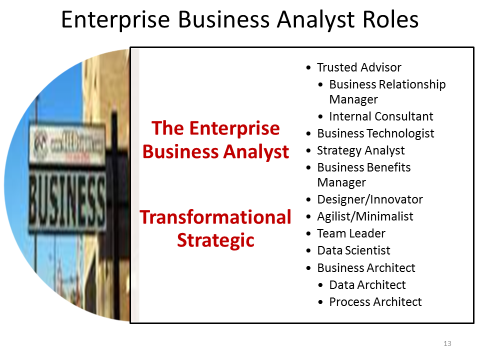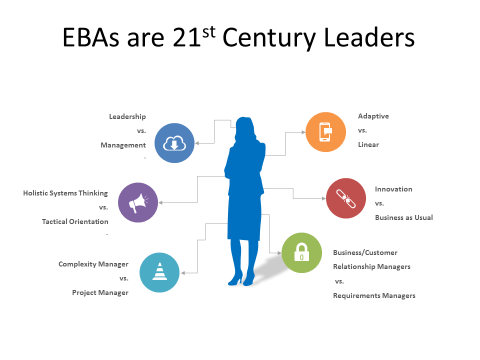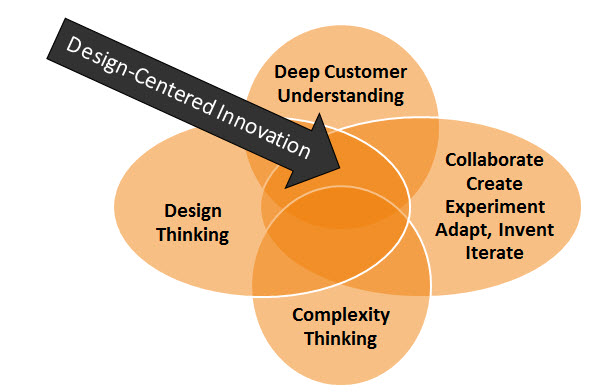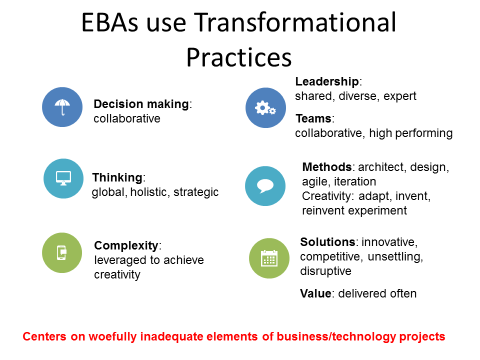In the 21st century, enterprise business analysts (EBAs) have emerged to fill the gap in strategic analysis needed to make appropriate decisions about the way forward for your organization and its enabling technology. According to Forrester: Technology-empowered, digitally savvy customers are changing the world, the economy, and business. How you (your organization) respond determines whether you win in the age of the customer.i
It is at the enterprise level that BAs can really make a difference by driving decisions based on value, and driving innovation based on creativity. Yet, EBAs have so many decisions to make about the direction of their careers that it can be overwhelming. It is tempting to sit back and just “see where our career is going.” But make no mistake, you are the decider! You need to continually develop, review and update your professional development plans, and then steer your career in the direction you have chosen. Three key areas for BAs to consider include:
Related Article: 21st Century BA: How to Become a Business Technologist
- Enterprise Business Analyst Roles,
- Business Domains, and
- Technology Domains.
ENTERPRISE BUSINESS ANALYST ROLES
No one individual can fill all of the potential roles of the enterprise business analyst. And as businesses mature and respond to the challenges of the marketplace, more roles are emerging at every turn. In this article, we examine the most prevalent EBA roles in play today:
- Trusted Advisor
- Business Relationship Manager
- Internal Consultant
- Business Technologist
- Strategy Analyst
- Business Benefits Manager
- Designer/Innovator
- Agilist/Minimalist
- Team Leader
- Data Scientist
- Business Architect
- Data Architect
- Process Architect
Prior articles discussed in depth how an EBA works as a Business Technologist. For this article we will discuss the additional critical enterprise roles, starting with a focus on EBA as trusted advisor and strategist….the very top of the food chain of the business analysis practice.

TRUSTED ADVISORS
To become a trusted advisor to middle- and senior-level managers, you must be perceived as a credible, knowledgeable, strategic thinker. The EBA role is to fill the gap in holistic thinking and creative leadership at the enterprise level of organizations. As this new leadership role emerges, don’t miss out!
There are several roles EBAs fill as trusted advisors. Make no mistake; these are leadership roles within organizations that are undergoing significant change. These roles are typically placed within the Professional Services or Shared Services groups of most organization models.

Business Relationship Manager
- Striking executive level relationships
- Ensuring effective executive sponsorship of projects
- Driving issue resolution to achieve business outcomes quickly
- Understanding the business context, and communicating a holistic view of the technology, data, and process perspectives
- Assisting in establishing priority and portfolio objectives by driving value management
- Managing change at the organization level and stakeholder impact level
Internal Management Consultant
- Act as a critical source of decision-support information to business leaders
STRATEGY ANALYST
Enterprise BAs provide the essential analysis needed for executives to make informed decisions about the future. EBAs lead strategic research and analysis activities to capture the information listed below to provide executives with decision-support information. Without this vital information, executives are flying solo. Exceptional strategic EBAs use tools (not templates), capture and validate the information in teams of diverse, credible, influential thinkers, and prepare lean, straight-forward executive-level reports. Decision support information includes:
- A deep understanding of customer needs and desires
- Competitive analysis and market research
- Current state capability analysis using easy-to-understand visuals including a typical SWOT analysis of strengths, weaknesses, opportunities, and threats
- Regulatory environment compliance and non-compliance analysis
- Strategy Road Maps. Capture all of the research information into an organizational roadmap including:
- Vision, mission, goals
- Strategy arenas, differentiators, economics, conduits
- Capability assessment
- Recommendations: solution, outcomes, risks
- Implementation approach prioritized by value
- Success criteria
- Strategy Execution Framework. Many organizations are unable to execute on well-formed strategy because they have no framework to guide them on the journey. The balanced scorecard has evolved from its early use as a simple performance measurement framework to a full strategic planning and management system. The balanced scorecard transforms an organization’s strategic plan from an attractive but passive document into the “marching orders” for the organization on a daily basis. It provides a framework that not only provides performance measurements but helps planners identify what should be done and measured. It enables executives to truly execute their strategies. Perspectives that are measured include the customer, financial, learning and growth, and process for a holistic view of progress towards achieving strategies. See link below for an example and explanation.
Learn more from the Balanced Scorecard Institute online at https://balancedscorecard.org/Resources/AbouttheBalancedScorecard/tabid/55/Default.aspx
BUSINESS BENEFITS MANAGER
In order to execute the strategy, someone needs to drive the analysis to convert the goals and objectives into valuable change initiatives. It is the EBA who brings the right people in the room and facilitates creativity sessions to identify innovative solutions, and then conduct a feasibility analysis of alternative solutions. The results of the analysis become proposals to build the most feasible solution in the form of a business case.
Typically, a business case is no longer used once a project has been approved, resourced, and funded, and implementation is underway. However, as you design and build the solution, it is the EBA’s job to continue to validate the expected costs and benefits, and update the business case. Alert your executive sponsor and steering committee if the original assumptions or projections are at risk, and recommend a course correction. This validation/update cycle is essential to keep the business case alive, particularly to keep everyone’s focus on the business benefits. Remember, the business case is developed when we know the least about the endeavor, so it will no longer be valid unless it is updated as more is learned.
After the new solution is deployed, measure the value to the customer and the effects to the bottom line. If the value of the solution does not measure up to the original benefit projections, recommend adjustments and improvements. Manage so that the worth of the solution is directly related to value to the customer and benefits to the business, both of which lead directly to wealth to the bottom line.
Innovation experts are advising us to abandon traditional business case methods, and focus on mini business cases (just seven or so slides) that propose change in the context of the customer and the innovative product. The trend today is to use a mini business case that will strengthen the persuasiveness of your proposals and get you noticed. Typical information includes:
1. The customer
The customer situation
The customer need
The customer problem/challenge
2. The product concept
The new product
The business model
3. The discriminator
Current solutions and competitors
Our competitive positioning
4. The feasibility
Technical feasibility
Cultural feasibility
Process feasibility
Economic feasibility
Marketing feasibility
5. The value
Value to customers
Wealth to bottom line
6. The timing
Why now
If we don’t do it, then….
7. The Decision
Further effort to confirm the viability
Further effort to examine uncertainties, risks, complexities
The team, the process and the timing.ii
DESIGNER/INNOVATOR
Innovative solutions very seldom emerge using traditional BA requirements elicitation techniques. Rather, design-centered EBAs realize that innovation is about designing a great customer experience. EBAs foster collaboration, creativity, and innovation when working with groups at all levels of the organization to design the transformation. Understanding that all people are creative, EBAs seed creativity across the organization. Your challenge is to learn quickly how to use design principles to foster creativity; prioritize these activities high in your professional development plans:
- Discover creativity-inducing tools and techniques used by facilitators everywhere for problem-solving and decision-making.
- Examine how to augment structured facilitation techniques with investigation, experimentation, and creativity-inducing activities.
- Learn how to reinvent your team facilitation model often to keep your teams engaged in the innovation process, whether working on incremental enhancements or breakthrough innovation.
- Discover the magic of design thinking, and how it is being used in progressive organizations to develop breakthrough solutions to complex business problems.

Design thinking is a collection of practices that help teams better identify with customer experiences, and shift from logical problem solving to creative experimentation. It involves multiple thinking approaches:
- Systems Thinking: holistic, linkages, logic, deductive. Think ecosystem.
- Inside-out thinking: business view of customer experience
- Outside in thinking: customer view of customer experienceiii
Universities and colleges across the nation are beginning to use design principles to teach their students how to design innovative, transformational solutions to complex problems (often referred to as wicked problems). The Institute of Design (D. School, http://dschool.stanford.edu/) at Stanford has become one of the trendy, most talked about drivers of design thinking because of the practices they are spreading around the world to improve our lives through a collaborative approach that inspires human-centered innovations. Design thinking is a mindset of combining creative and analytical thinking and applying it toward solving a specific problem. Stanford offers a crash course with the tag line: Be a Design Thinking Facilitator! The process includes six steps:
- Empathy: understanding your customer through observation, engagement, immersion
- Define: drafting a problem statement from needs
- Ideate: brainstorming wild and crazy ideas
- Prototype: experimenting, welcoming early failure, inventing, re-inventing
- Test: gauging customer desirability, financial and technical feasibility, business viability
- Repeat
You will know Creative Leadership when you see it. Teams are engaged in constructive dialogue. The EBA is considered an expert facilitator. People want to work on her teams. The EBA has exceptional technical skills, deep knowledge of the business, a highly flexible style, superb relationship-building skills, and is comfortable with uncertainty. Often innovation teams are removed from the day-to-day operations, fully funded, fully supported from the top, but time-boxed to bring about innovation before the competition.
AGILIST/MINIMALIST
Agile projects are those that involve incremental delivery of value to the customer. Let’s face it: Agile projects are more successful. Standish Group provides us with this information, based on more than 10,000projects from 2011-2015 segmented by agile process and waterfall method.iv

Agile, incremental projects are taking the world by storm because iteration is the best defense against complexity and risk. Smaller projects are just simply easier to manage because of the reduced number of decisions that must be made and dependencies that must be managed. Start by mastering the lingo of the agile movement: (there is always new terminology!):
- Communication – visualization, daily stand up meetings
- Consensus – collaboration, co-location
- Business case – business value
- Requirements – product backlog, user stories, story maps
- Solution Scope – product vision
- Documentation – sticky notes
- Project management – self-organizing teams
For each successive iteration, implement the minimally viable solution. Strive to make these basic principles apply to all projects:
- Active user involvement is imperative, as it is about the customer experience
- The team must be empowered to make decisions
- The timescale is fixed; this helps minimize scope and accelerate decision-making
- Capture requirements differently, lightweight & visual; requirements evolve
- Develop small, incremental releases and iterate
- Focus on frequent delivery of products prioritized based on value
- Complete each feature before moving on to the next
- Apply the 80/20 rule (remember, only 20% of features are typically used)
- Testing is integrated throughout the project lifecycle – test early and often
- A collaborative & cooperative approach between all stakeholders is essentialv
Despite the evidence that agile management is successful, organizations are having difficulty transitioning to an agile approach to projects. Institutionalized structures and processes are designed to support the more serial approach to change. It’s a leadership issue. EBAs are well positioned to provide the requisite leadership and to help accelerate the transition to bring about value to customers and to the organization quickly, thus sustaining or advancing competitive advantage.
TEAM LEADER
EBAs spend most of their time working through and with others; they are famous for pulling teams together to bring about innovative results quickly. Sometimes team members are not located in the same place, making team leadership even more challenging. Global teams are a vital asset to expand resources and to capture the nuanced preferences of different global markets. Indeed, about 80% of our project teams in existence today have members who are not physically co-located. And the trend is only going to continue. For many CEOs, seeking partnerships and forming global teams is a high-priority endeavor. EBAs are stepping up to assist in this struggle.
EBAs understand that virtual teams add a significant amount of complexity to change initiatives. The challenges of virtual teams include:
- Fostering creativity at a distance
- Building and sustaining great teams of diverse characteristics
- Distributed team leadership, communication, collaboration, and decision-making
- Using virtual teams as a strategic advantage
- Encouraging innovation through edge-of-chaos leadership
- Managing agile distributed teams with a light touch
- Managing innovation projects that are always urgent at a distance
- Leading unplanned, urgent projects as they emerge
EBAs also understand that high-performing teams share a number of characteristics:
- Team members are diverse, high trained and highly practiced
- Clear goals, direction, priorities
- Clear roles among team members
- Cooperation
- Engagement
- Prioritization based on value
- Common expectations
- Robust communication
- Defined decision-making practices
EBAs are stepping up to manage the numerous transformational change efforts facing organizations today. Transformational change is profound, fundamental, disruptive, and irreversible, and it is essential today for organizations to remain viable. It involves breakthrough practices, structures, businesses, and technologies. Incremental continuous improvements to the way we do things today are not enough in the 21st century inter-connected, innovation-driven economy. Transformation requires:
- Visionary leadership, a holistic approach
- Clear understanding of goals
- Understanding of the ‘as-is current state’, the ‘to be innovative future state’, and the gap between them
- Sophisticated risk management and change management

DATA SCIENTIST
In this knowledge economy, your business is smart when it acts on the basis of data, information, and rules. It is the EBA who becomes the business intelligence specialist – the data scientist. Converting data into information that can be used to make decisions. There are a myriad of components that comprise business intelligence:
- Customer behaviors
- Competitive trends
- Technology trends
- Business rules
- Operational business decisions
- Business analysis
- Business architecture
- Business processes
- Business vision, mission, strategy
- Business policy monitors (KPIs)
ARCHITECT
Business architecture is a holistic view of the business and the supporting technology. It is a set of visual and textual representations of the essential components of a business and their relationships. It can be thought of as a blueprint used to plan change and align strategy with execution. EA supports business transformation by providing a holistic approach for planning change, provides a common understanding, leverages new technology capabilities, and harnesses the unwieldy IT environment. Many organizations focus on just the IT architecture. A holistic view includes both business and IT capabilities that are viewed as an integrated whole. Strategic capabilities include the following. EBAs sometimes specialize in one or more of these areas.
- Business capabilities: functions, structures, processes
- Information capabilities: information entities, application portfolio
- Technology capabilities: supporting technology
- Solution capabilities: business applications and tools
Business architectures are used as a tool to communicate about the business. Business architecture is developed and used by visionaries, strategists, executives, architects, managers, consultants – everyone working at the enterprise level. Then project teams build out the details of the architecture for the areas undergoing change. Change-driven organizations are using architectures because they bring about a certain level of maturity, an understanding of enterprise capabilities.
Leading-edge businesses are embracing architectural techniques to begin to ‘think visually’ about the enterprise and the innovative solution. Through architecture, we increase business agility by managing change visually. Business architectures integrate disparate views of the enterprise to facilitate innovation through rich pictures (sometimes called ‘picture thinking’). The EBA often fills an architectural role, facilitating groups of business experts to ‘design the business’.
Business architects and business process professionals have traditionally focused on designing durable business processes that can stand the test of time. However, new technology disruptors such as mobile and social are forcing teams to rethink business and process design from an outside-in perspective. To deliver next-generation business process solutions, business architects, and business process professionals are shifting from “systems thinking” paradigms that emphasize process modeling to “design thinking” paradigms that emphasize creativity and customer experience. This will require teams to adopt emerging strategies and practices for integrating design thinking principles into their business process management (BPM) initiatives. According to IBM, the key questions are these:
How can your organization achieve sufficient business agility to accomplish your objectives among growing economic uncertainty? Does your business model take advantage of smarter technology and differentiating capabilities? Ultimately, are you capitalizing across business and IT to embrace increasing complexity to become a standout performer in your industry?vi
DECIDE WHICH ROLE YOU WANT TO PURSUE
Working at the strategic, enterprise level is vastly rewarding. Leap from a project-focused BA to an enterprise business analysts (EBA) in a single bound. You can then be a part of crafting the future of your company.
However, there are additional decisions to be made. Which business domain are you passionate about (financial, healthcare, engineering, education, etc.)? Which domains are out there looking for enterprise, holistic thinkers and problem solvers? The EBA role can be very challenging, so it helps immensely if you are forging the future in the business domain that excites and rewards you. Once you have chosen the business domain, research to see which technologies are emerging to support better or even drive the future of that domain. Future articles will examine the domains that are undergoing transformations and the technologies that are enabling the change.
i https://www.forrester.com/home/
ii Gijs van Wulfen, May 23, 2014 Blog. “How to Present your Idea to Top Management”. Online at: https://www.linkedin.com/today/post/article/20140523142826-206580-how-to-present-your-idea-to-top-management?trk=prof-post (accessed May 2014).
iiiFranz, Annette, August, 2015. Outside-In vs. Inside-Out Thinking, Online at: http://www.cx-journey.com/2015/08/outside-in-vs-inside-out-thinking.html
iv Standish Group, Standish Group 2015 Chaos Report – Q&A with Jennifer Lynch, October, 2015. Online at: http://www.infoq.com/articles/standish-chaos-2015/
v Waters, Kelly, 2007. What is Agile? Online at: http://www.allaboutagile.com/what-is-agile-10-k
vi Design For Disruption: Take An Outside-In Approach To BPM, Forrester, Online at: https://www.forrester.com/report/Design+For+Disruption+Take+An+OutsideIn+Approach+To+BPM/-/E-RES91465









